The industrial ceramic floor tile in France
Mario Baeck, doctor in art sciences

Jean-Baptiste Aimé Boulenger
After the Napoleonic wars there was in many countries of continental Europe - as in England - a growing interest for medieval and Renaissance art. Together with the Gothic Revival movement this led in France, as well as in Germany and Belgium, to the scientific study of old floor tiles found during excavations in old monasteries and castles. This resulted in a growing demand for such tiles which lead in itself to a breakthrough for a more industrial production of ceramic encaustic floor tiles in plastic clay, as well in England as on the continent.
It is well known that in England Samuel Wright of Shelton in Staffordshire reintroduced the production of encaustic floor tile in plastic clay by patenting a proper technique for it on 26th January 1830, a technique which was further successfully developed by Herbert Minton and Walter Chamberlain. Two decades later a similar production was started in France. There, Joseph- Achille Boulenger, who had started in 1848 a brick factory in Auneuil (Oise), was in 1854 joined by his elder brother Jean-Baptiste Aimé.
Probably inspired by Minton’s and Chamberlain’s success in England, they then started with the production of encaustic floor tiles in matt “grès” or stoneware in the “pâte molle” technique where the designs were created by pressing plastic clay into plaster moulds. These were the first modern encaustic tiles in France. Boulenger was awarded a honourable mention for their tiles on the World Exhibition of 1855. Many Boulenger tile designs of the first period were based on medieval examples published in 1859 in Emile Amé’s Carrelages émaillés du Moyen Age et de la Renaissance. After the death of both brothers the firm continued under the name S.A. de Produits céramiques d'Auneuil. From this period a catalogue with 253 different designs has been preserved.

Scan from the Boulenger catalogue of 1858

The Boulenger factory at Auneuil (Oise), France

Reverse tile stamp 1878
Dust pressed encaustic floor tiles
The production of encaustic tiles in the dust press technique on a large scale has long been considered to be based on an innovative invention by the Birmingham engineer Richard Prosser patented on 17th June 1840, and taken shortly afterwards in production by Herbert Minton in Stoke-on-Trent. However, this technique was in England in the two decades after 1840 only used for the production of single coloured floor tiles, tesserae and wall tiles. The production of the dust press technique for producing encaustic tiles was indeed in England only patented by William Boulton and Joseph Worthington on 3th September 1863 and for encaustic tiles imitating Roman mosaics by Maw &Co in 1864. In addition, research based on many contemporary English and continental sources (Mario Baeck, ‘The myth of an invention: the early developments of dust-pressed tile manufacturing on the European continent’, in: Journal of the Tiles & Architectural Ceramics Society, Volume 25, 2019, p. 22-38), brought to light that the dust press technique claimed by Prosser was already patented in France in 1804 by the Englishman Christopher Potter (1750-1817) and was thus for some decades already well known on the continent, as well as in England were it was known from the 1820s onwards by Chamberlain of Worchester through the experienced French ceramicist Pierre Honoré Boudon de Saint-Amans (sometimes spelled Saint-Amand, 1774-1858).
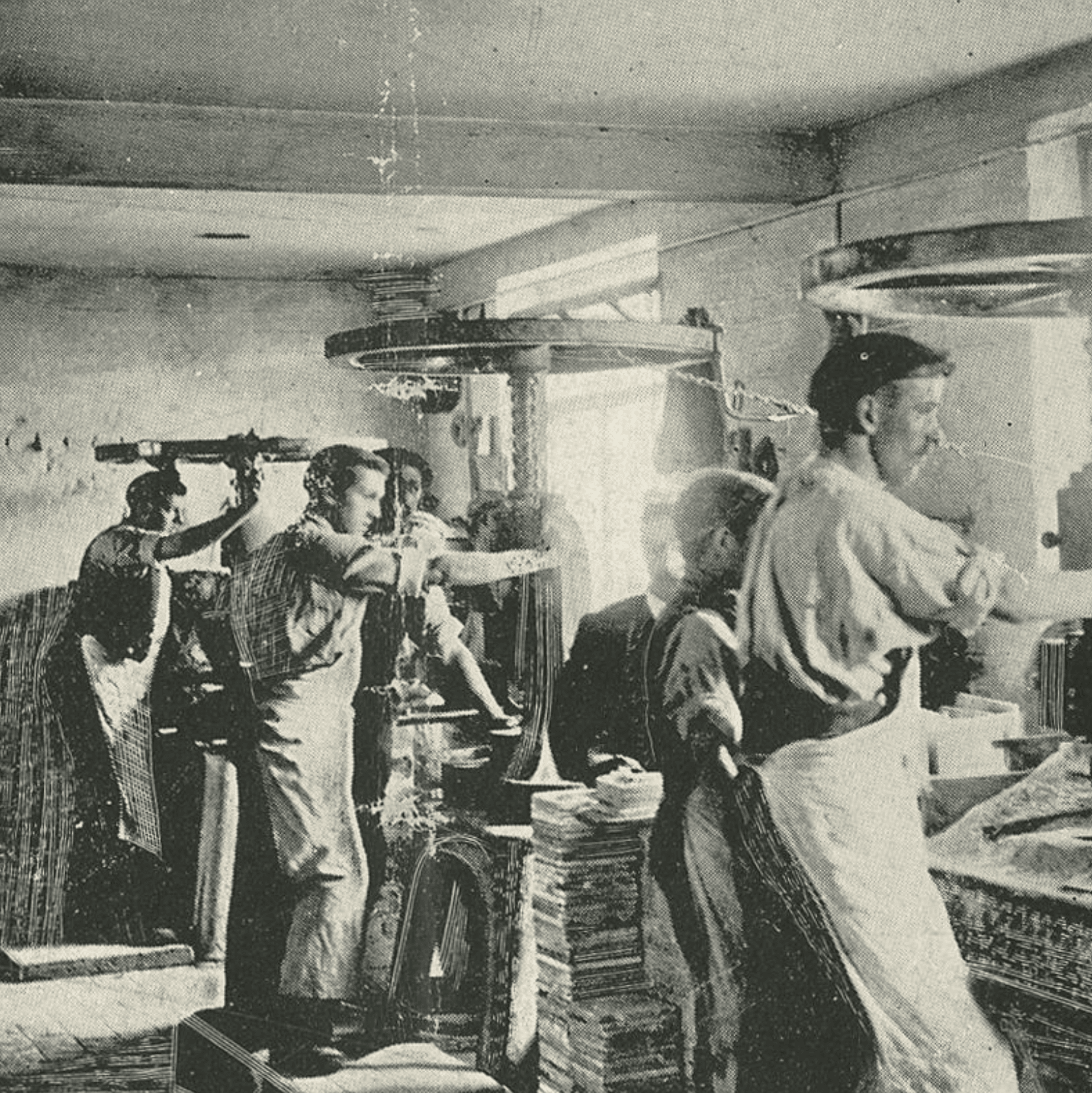
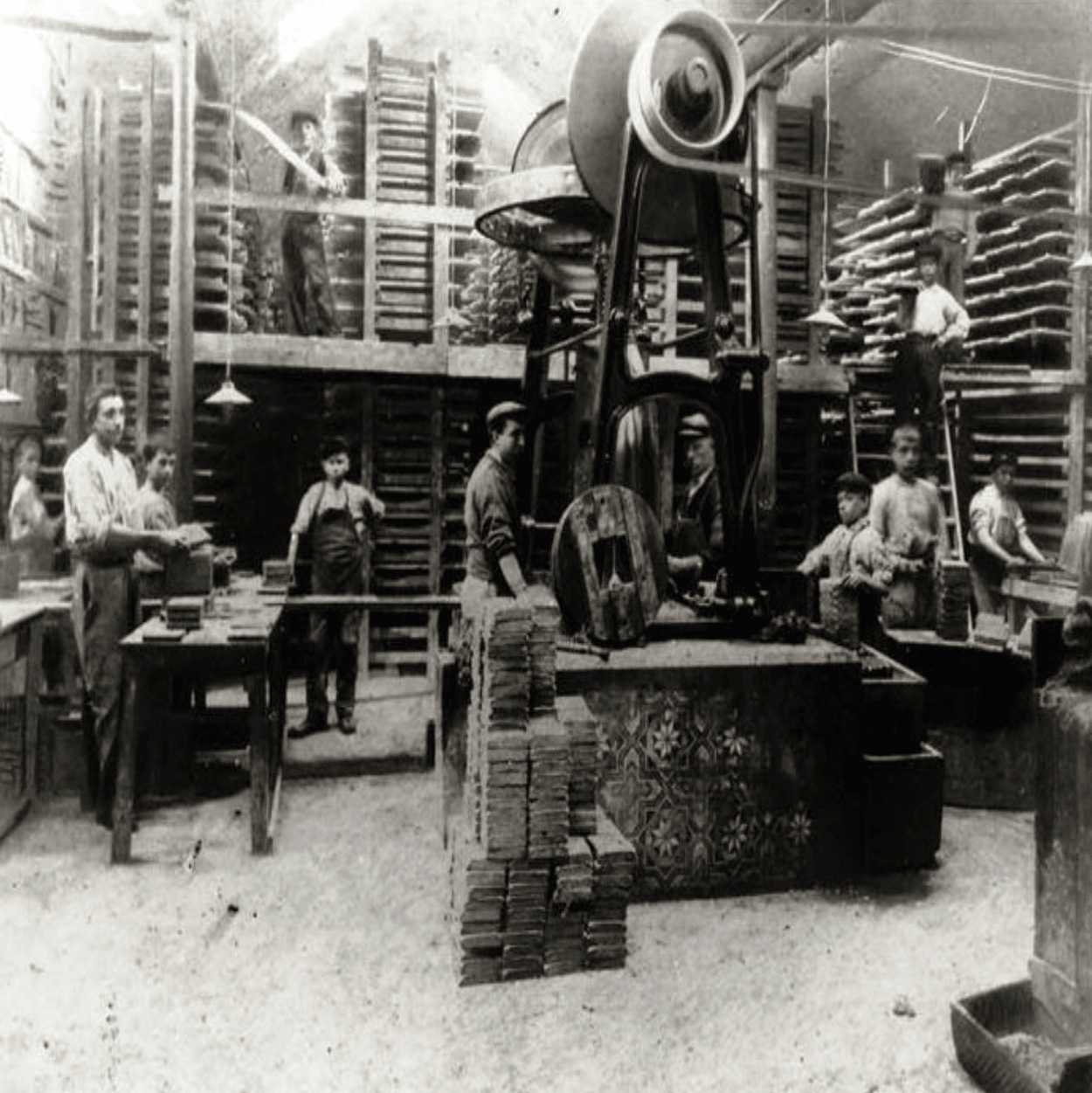
Handmade tile production – late 19th, early 20th century
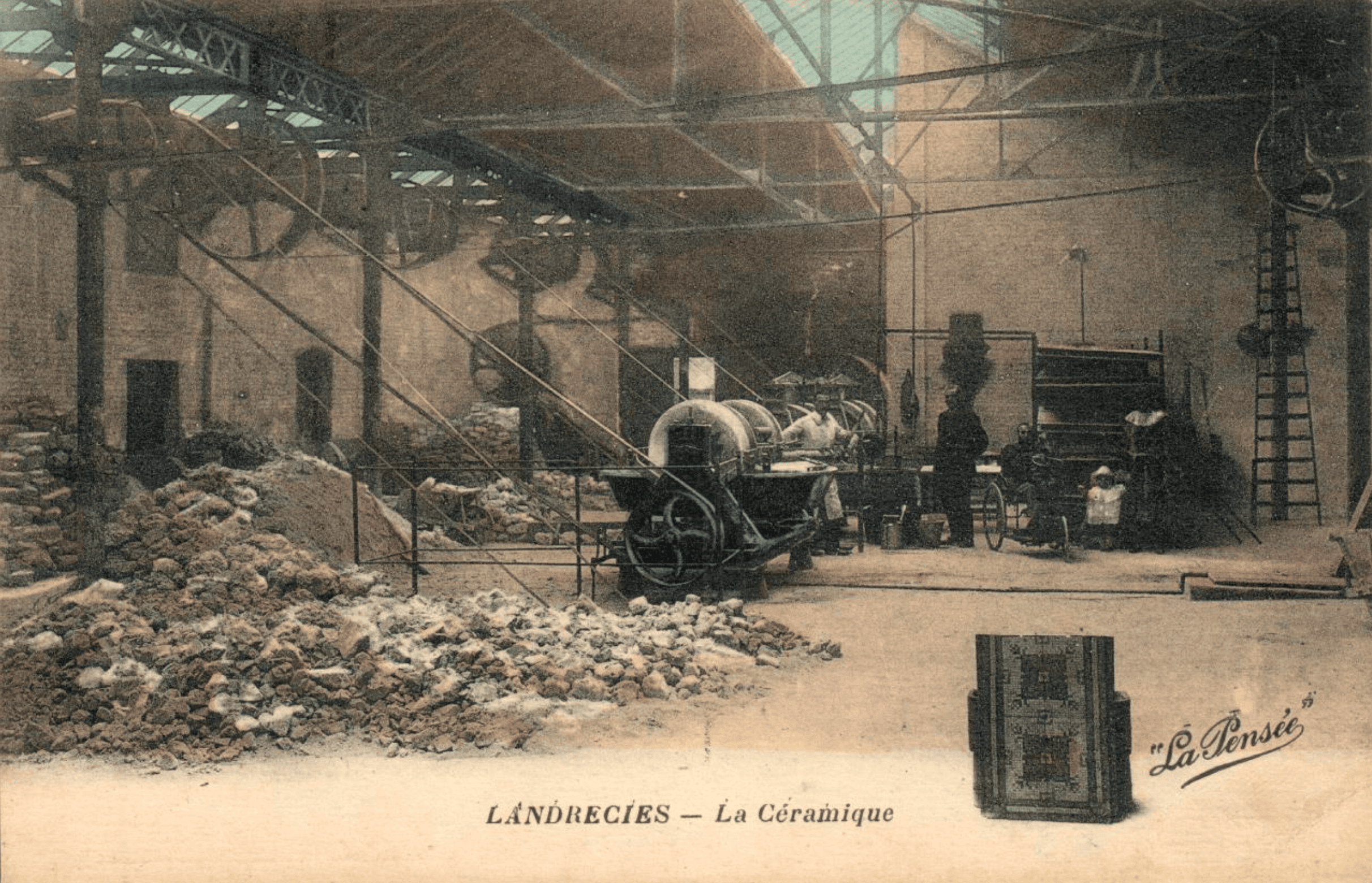
‘Broyeurs’, at the Landrecies factory, grinding the clay to fine dust for tile production
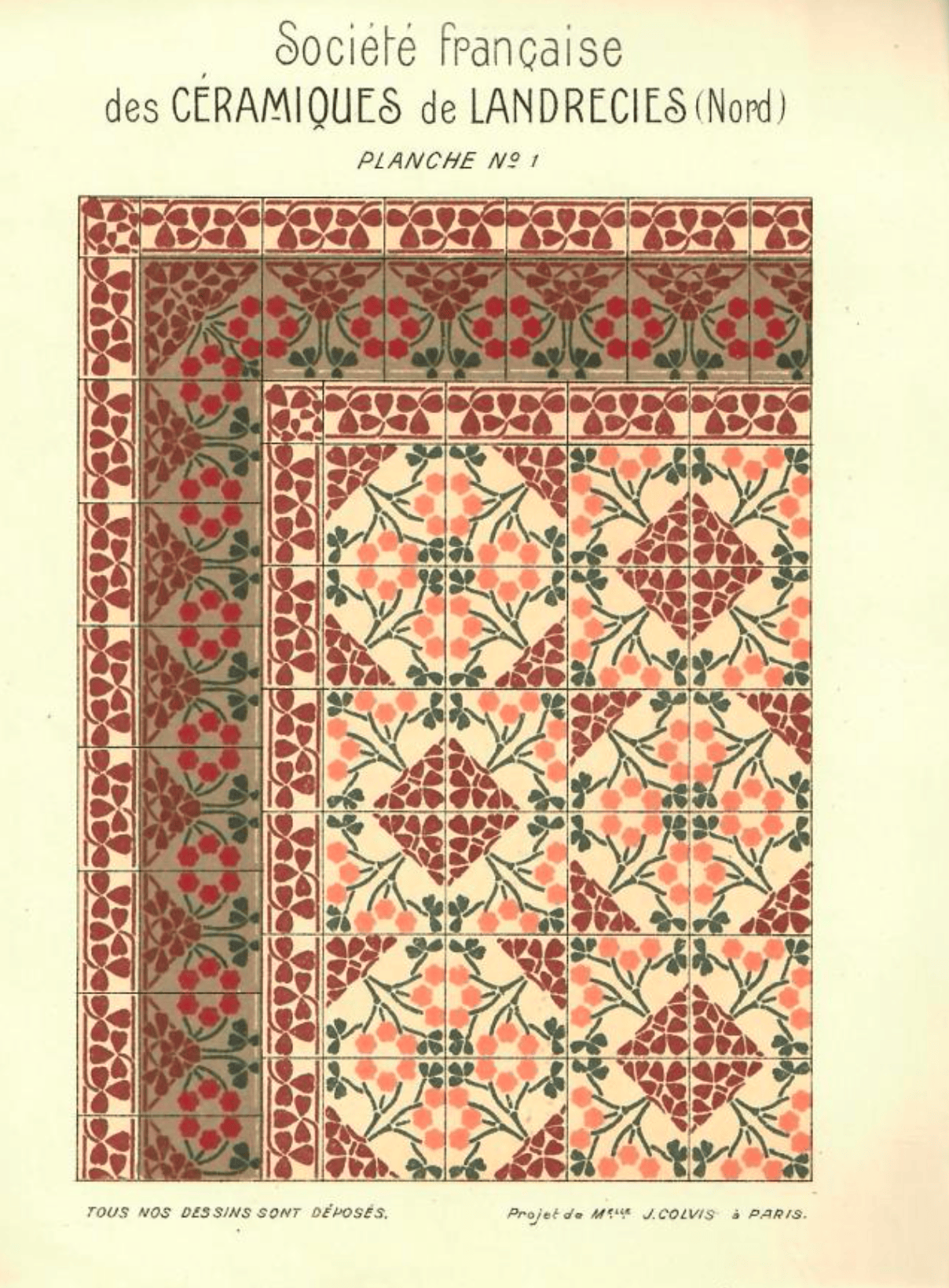
A scan from the period Societe francaise des Ceramiques de Landrecies catalogue
Experiments in Germany, Luxemburg and Belgium – the crucial role of the Boch family
The dust press technology initiated by Potter in France was on the continent further developed through experiments at the end of the 1830s by Ernst March (1798-1847) of Berlin in Germany, and from 1846 onwards by Villeroy & Boch in Luxemburg and Germany and by Boch Frères in Belgium and France. Indeed, after initiating the dust press technique for the production of single coloured tesserae and tiles in its factories in Septfontaines (Luxemburg) in 1846 and then applying it to the production of inlaid or encaustic tiles in Mettlach (Germany) from 1852 onwards, the Boch family began this same production in La Louvière, in the territory of the very young Kingdom of Belgium. After the success of their dust pressed encaustic tiles achieved at the Universal Exhibition in London in 1862, which earned them a medal - as they were found simple in pattern, excessively hard, and very cheap -, the production of La Louvière was transferred in 1862-1863 to a brand new factory in Louvroil, near Maubeuge, in France (Nord) in order to supply the much bigger French market free from customs interference, and this until 1936 when production was stopped due to changing tastes.
In 1870, Boch Frères already had a hundred different floor pattern designs on offer. In addition, designs from the sister firm Villeroy & Boch in Mettlach were also put on the market thus immediately creating a very diverse supply. It was a policy that clearly paid off for Boch Frères, because in 1870 there was not only a great demand for Boch tiles from France and Belgium, there was also a lot of export to the United Kingdom, the Netherlands, Italy, Algeria, Egypt and even China. In Maubeuge then 400 workers were employed and three steam engines and five ovens were in operation.
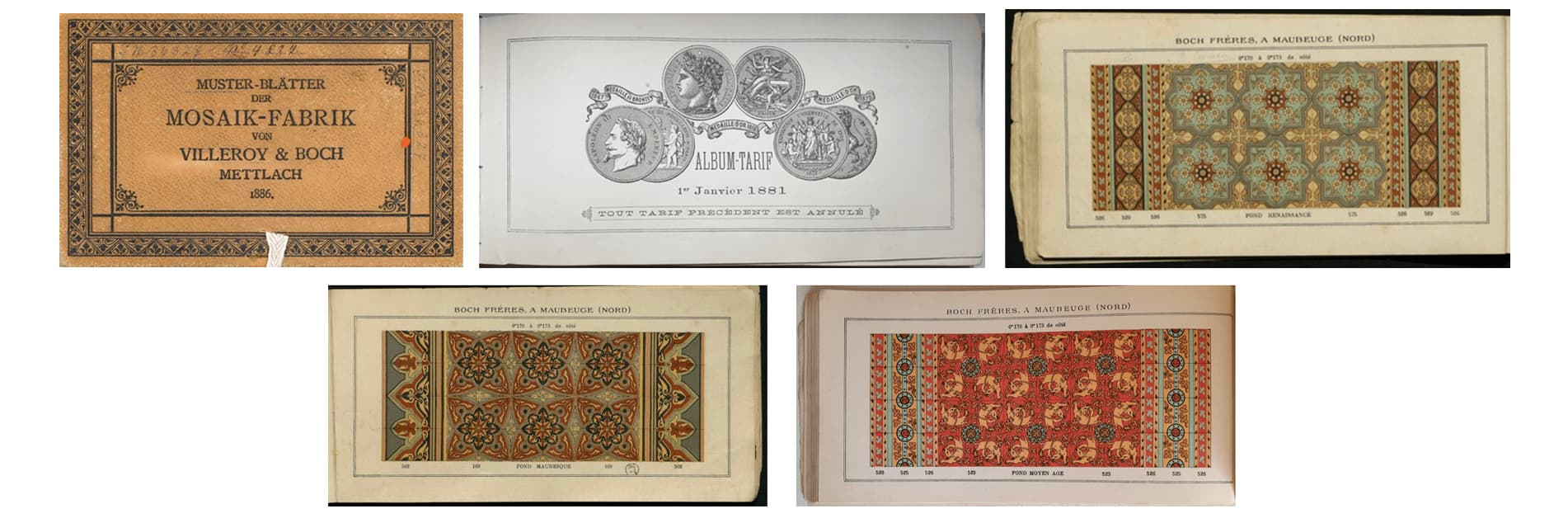
Scans for the period Boch Freres Maubeuge catalogues of 1881 -1905
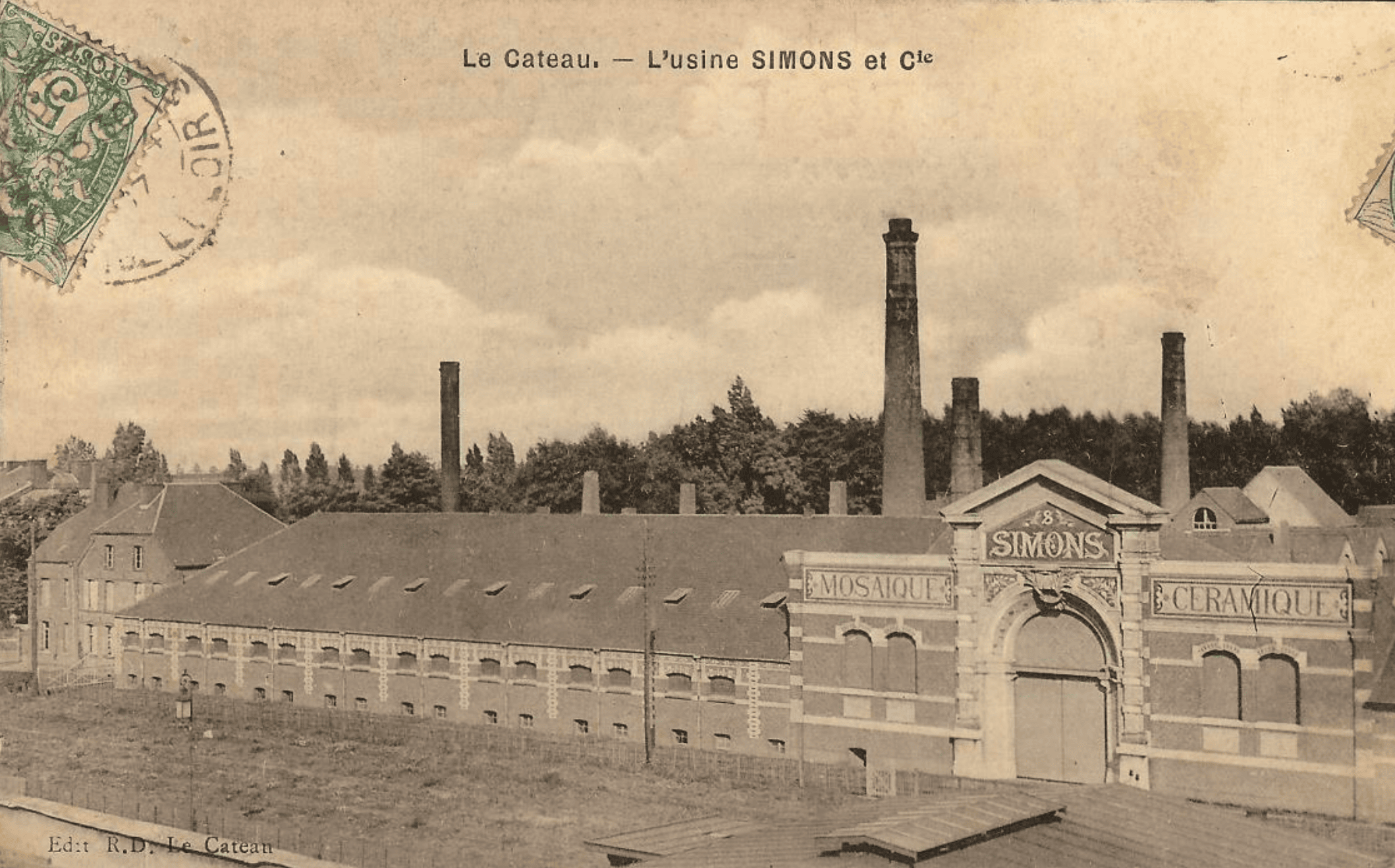
The Simons & Cie factory at Le Cateau
The founding of three new factories in the slipstream of the Boch success
After the war of 1870-1871, France experienced a decade of great economic and industrial growth. Encaustic tiles executed in the most diverse styles became an enormously successful product. So it was no accident that at this precise moment a number of competitors set up factories. The necessary technological know-how came three times straight from Boch Frères as three consecutive directors of the Boch factory left the company to start a competing tile factory elsewhere in France.
Paul Simons, the first director of the Boch factory in Louvroil, left in 1868 to set up his own factory in Le Cateau (Nord) in 1870. The S.A. Manufactures de Carrelages Céramiques Simons – which remained active until 1999 – soon was just as important as the Boch factory. In addition to encaustic floor tiles the firm later also made mosaics, which is rather unusual.
Two other Boch managers followed his example. In 1872 Jacques Eugène Sand, director from 1868 to 1872, set up the Manufacture de Carrelages Mosaïques en grès cérame, Sand & Cie in Feignies near Maubeuge (Nord).
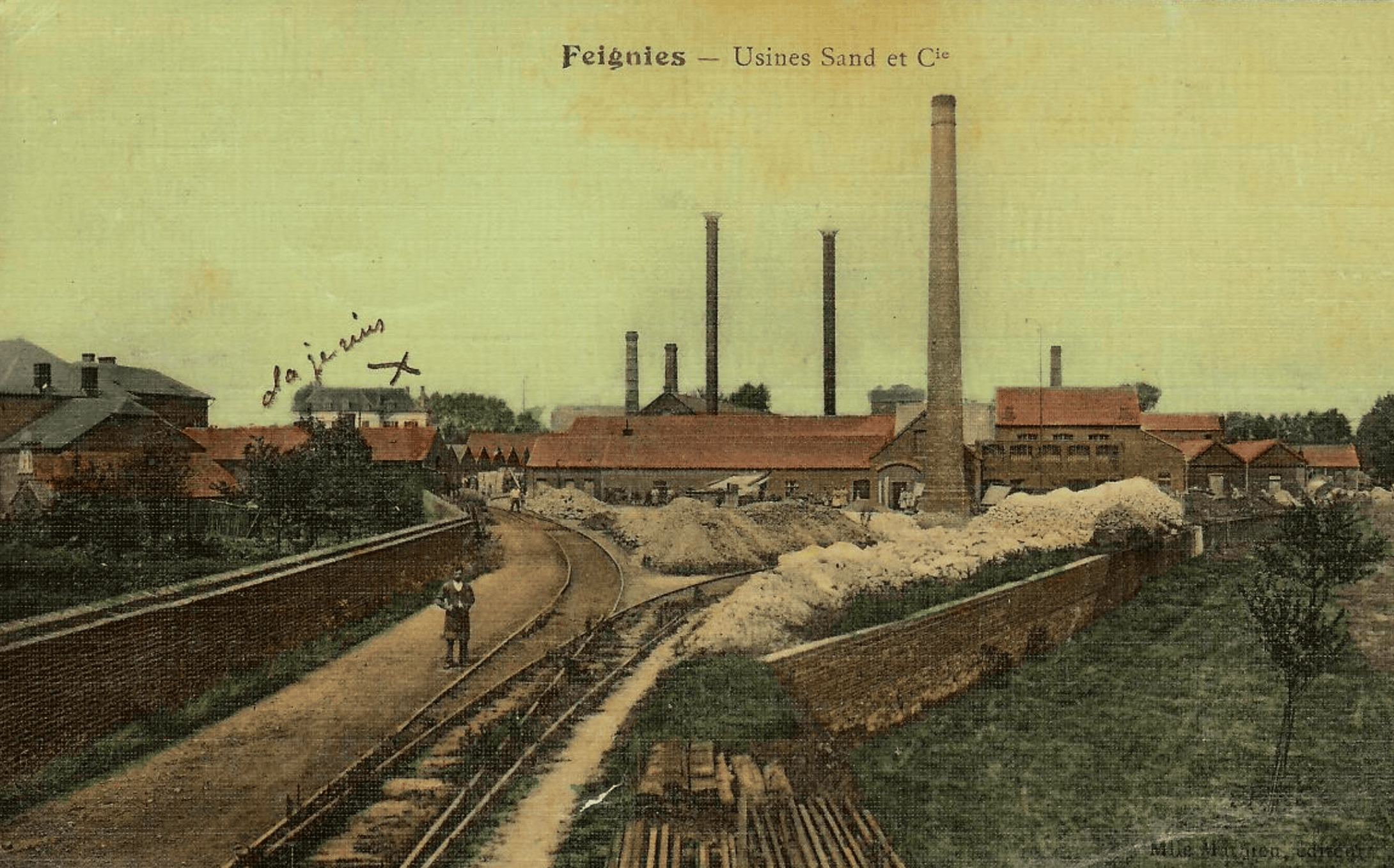
A colorised photograph of the Sand & Cie factory at Feignies, late 19th century
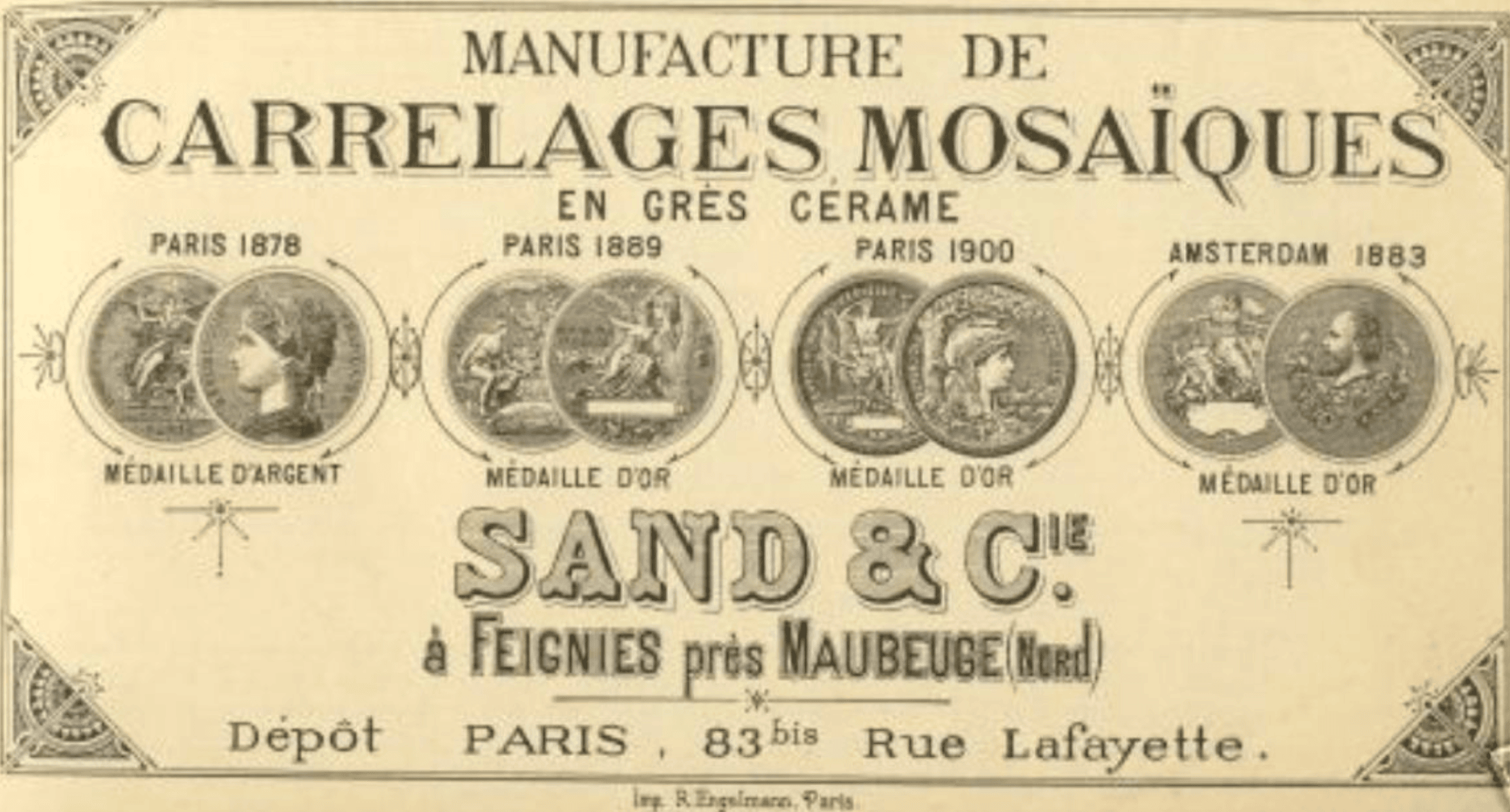
And in 1877 Paul Charnoz, Boch director from 1873-1877, founded a third rival firm in Paray-le-Monial (Saône-et-Loire). In addition to standard products Paul Charnoz & Cie carried out several prestigious commissions of great decorative finesse which gained them several gold medals and honorary diplomas at universal exhibitions. However, in 1891, financial problems forced Charnoz to sell his factory to the Utzscheider-Jaunez Company, but he remained its technical director and continued his creations within the company that took the name S.A. de carrelages céramiques de Paray-le-Monial until 1915. In 1923, the factory joined the Compagnie Générale de Céramique du Bâtiment, better known under the name Cérabati, and was active until 2005.
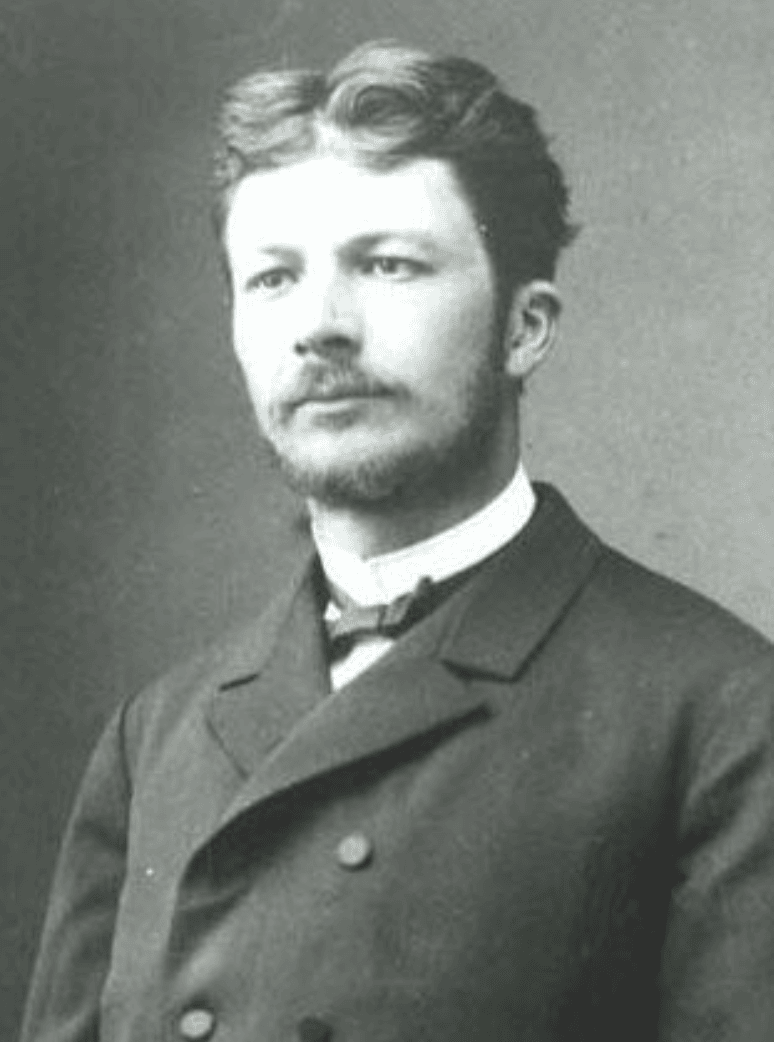
Paul Charnoz
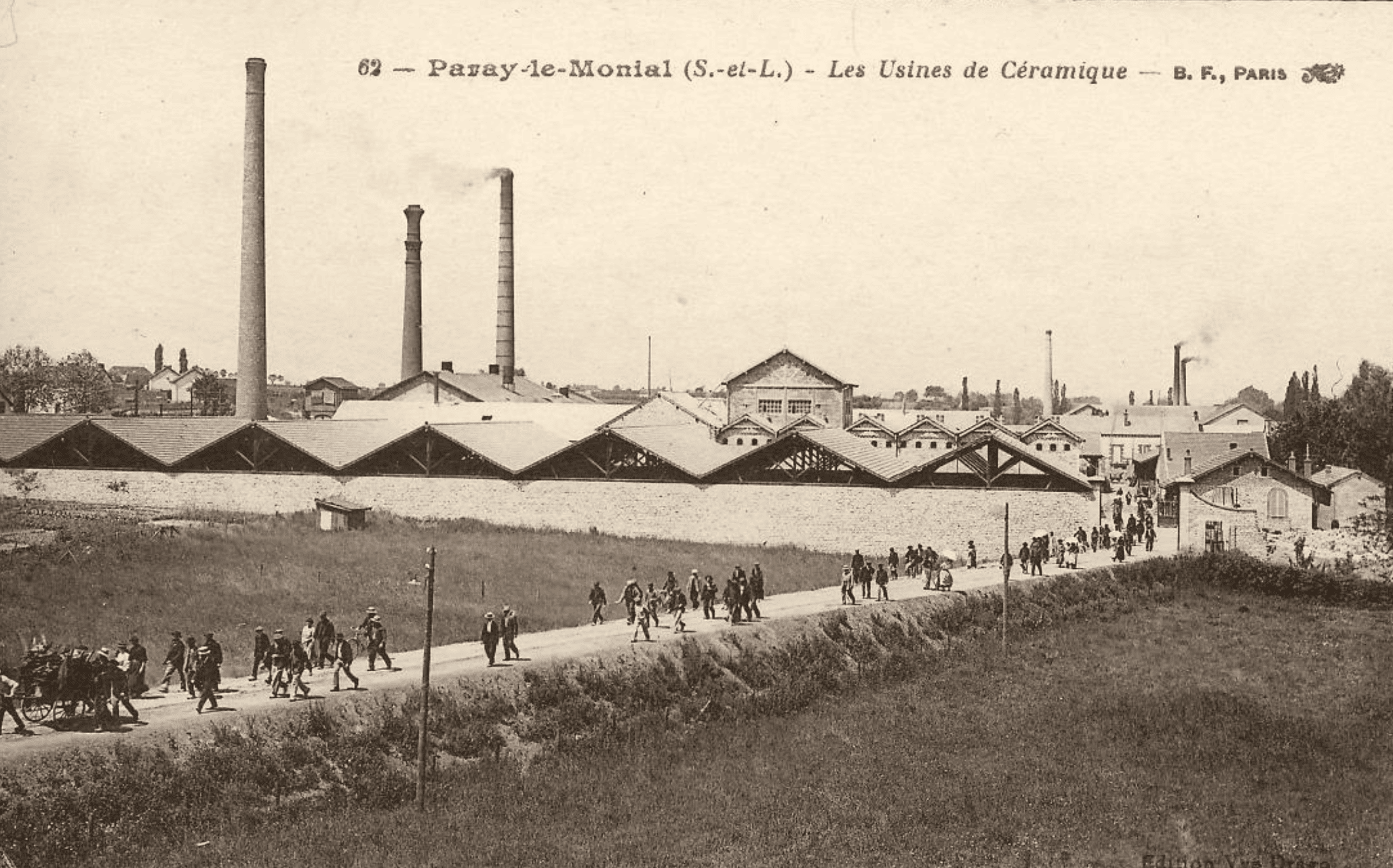
The factory at Paray-le-Monial, Saone et Loire, France
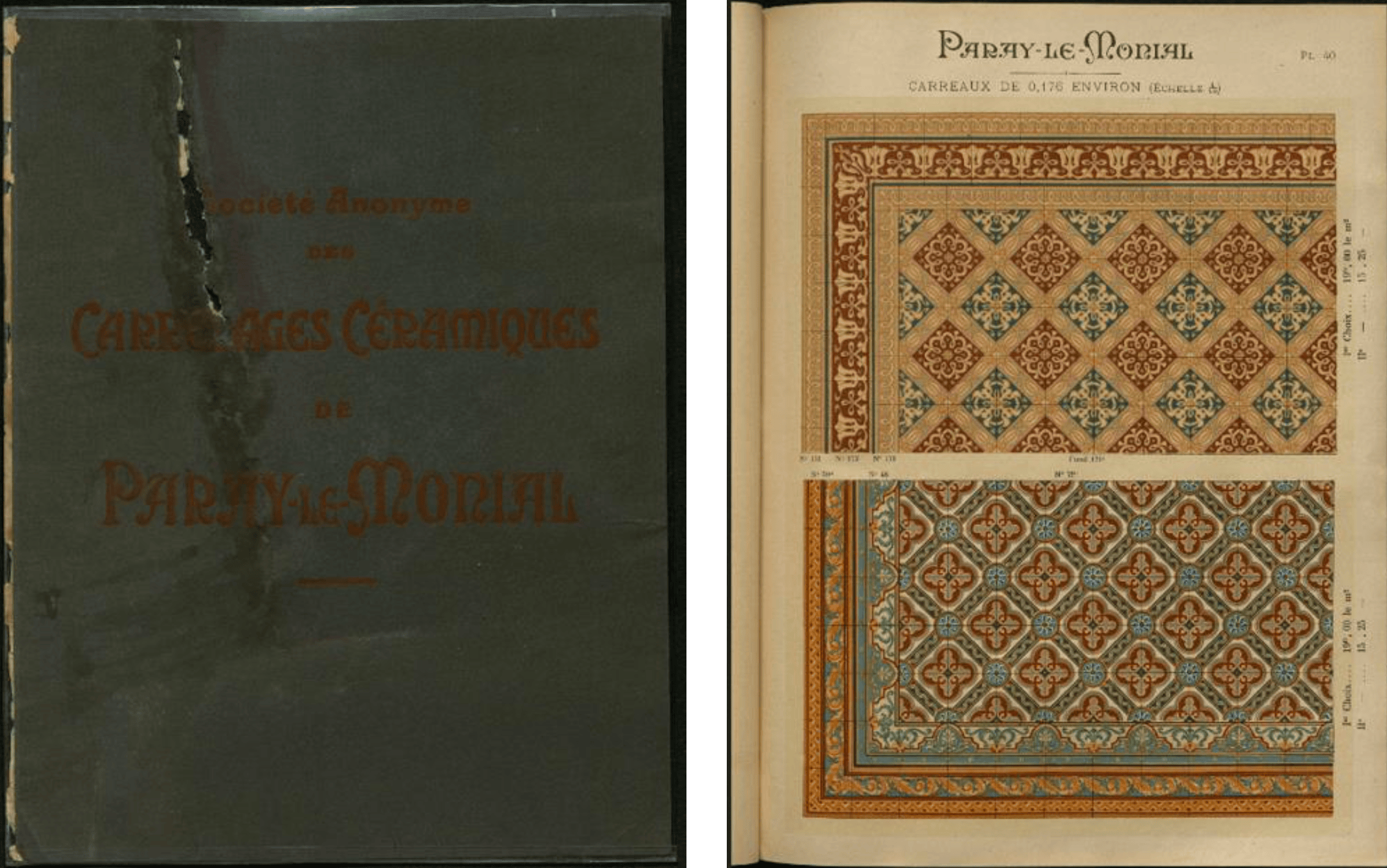
Scans from the Carrelages Ceramiques de Paray Le Monial catalogue
A fast growing production field
In the “Centre” region Jean-Marie Perrusson (1833-1900) had founded in 1860 a brickyard at the “9e écluse” in Ecuisses (Saône-et-Loire). Already in 1862 he added the production of roof tiles and plain floor tiles and the factory soon became well known as the Grande Tuilerie Méchanique de Bourgogne Perrusson-Perrusson. In 1880 Perrusson père et fils associated themselves with Marius Desfontaines so that the firm since then was known as the Grandes Tuileries Perrusson & Desfontaines. The production of encaustic stoneware floor tiles in two colours is already presented in their trade catalogue N° 3 of 1873. In addition, a first multicoloured pattern seems to have been presented in their catalogue N° 6 of 1880, and in their catalogue N° 7 of 1882 this has broadened to a whole range of multicoloured encaustic floor tile patterns. The production of the colourful encaustic tiles remained successful until the end of the 1930s. In 1959 the Perrusson-Desfontaines company went into liquidation and in 1960 the Ecuisses factory was closed definitively.
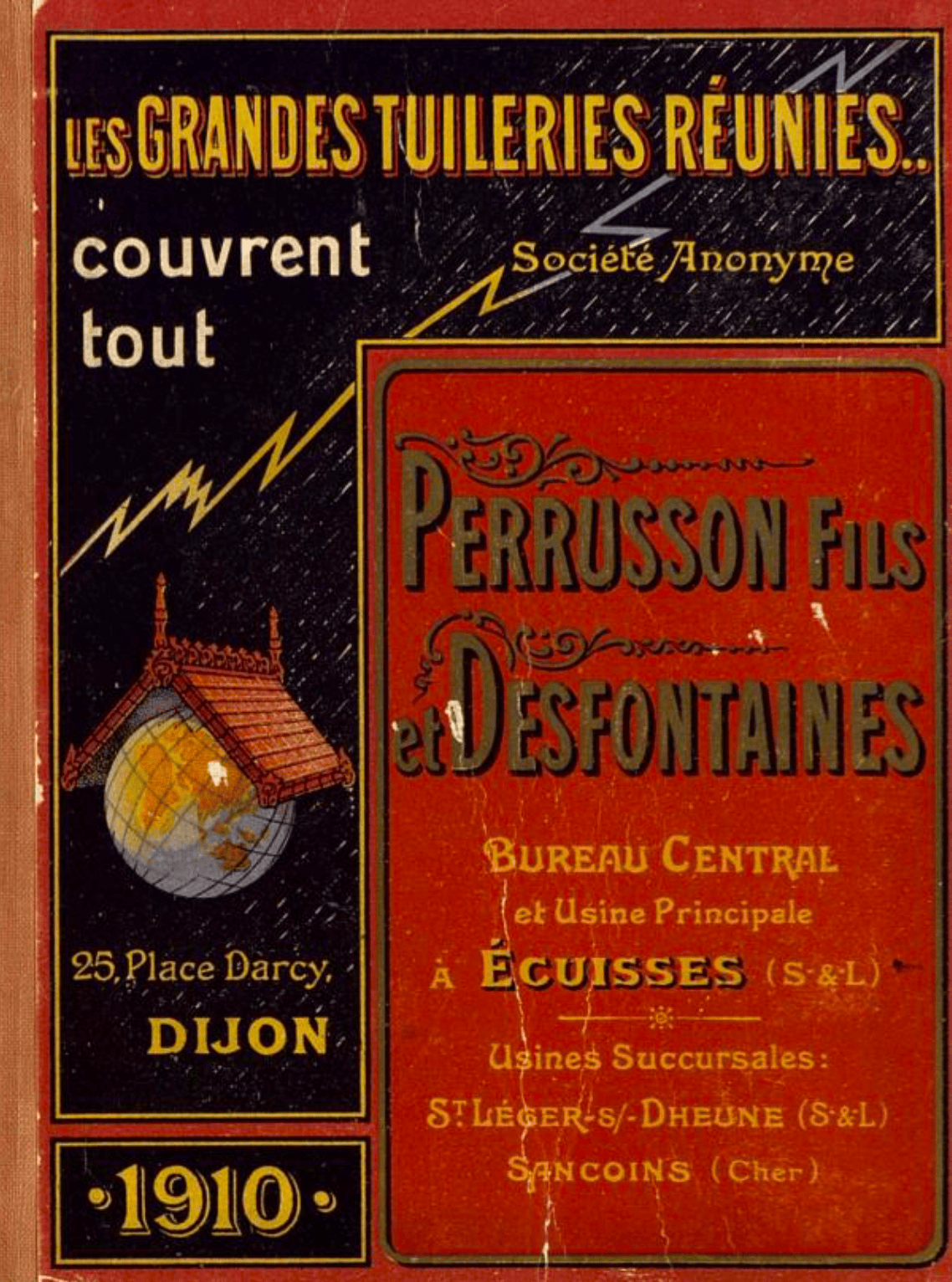
Perrusson Fils et Desfontaines Catalogue cover – 1910
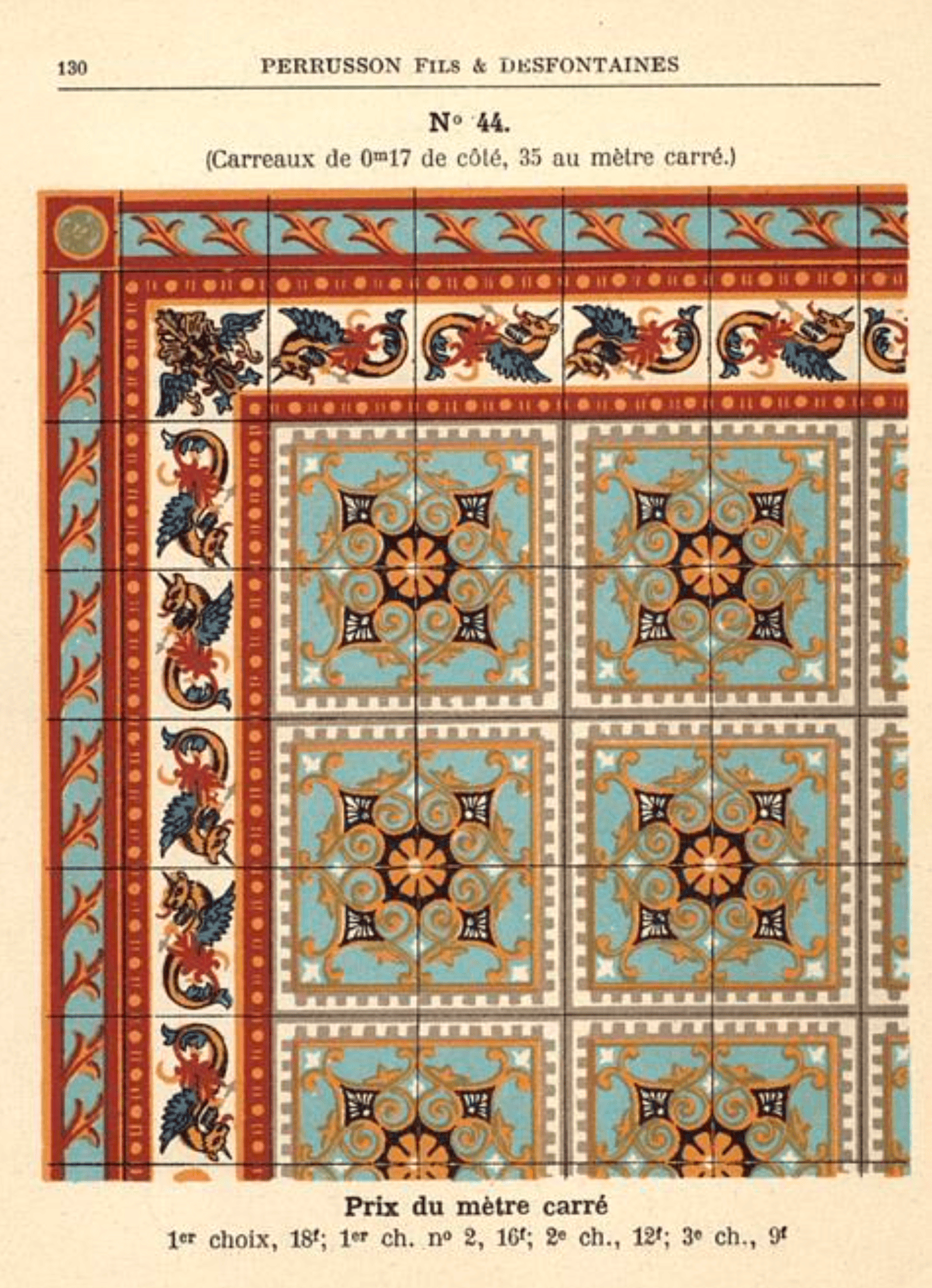
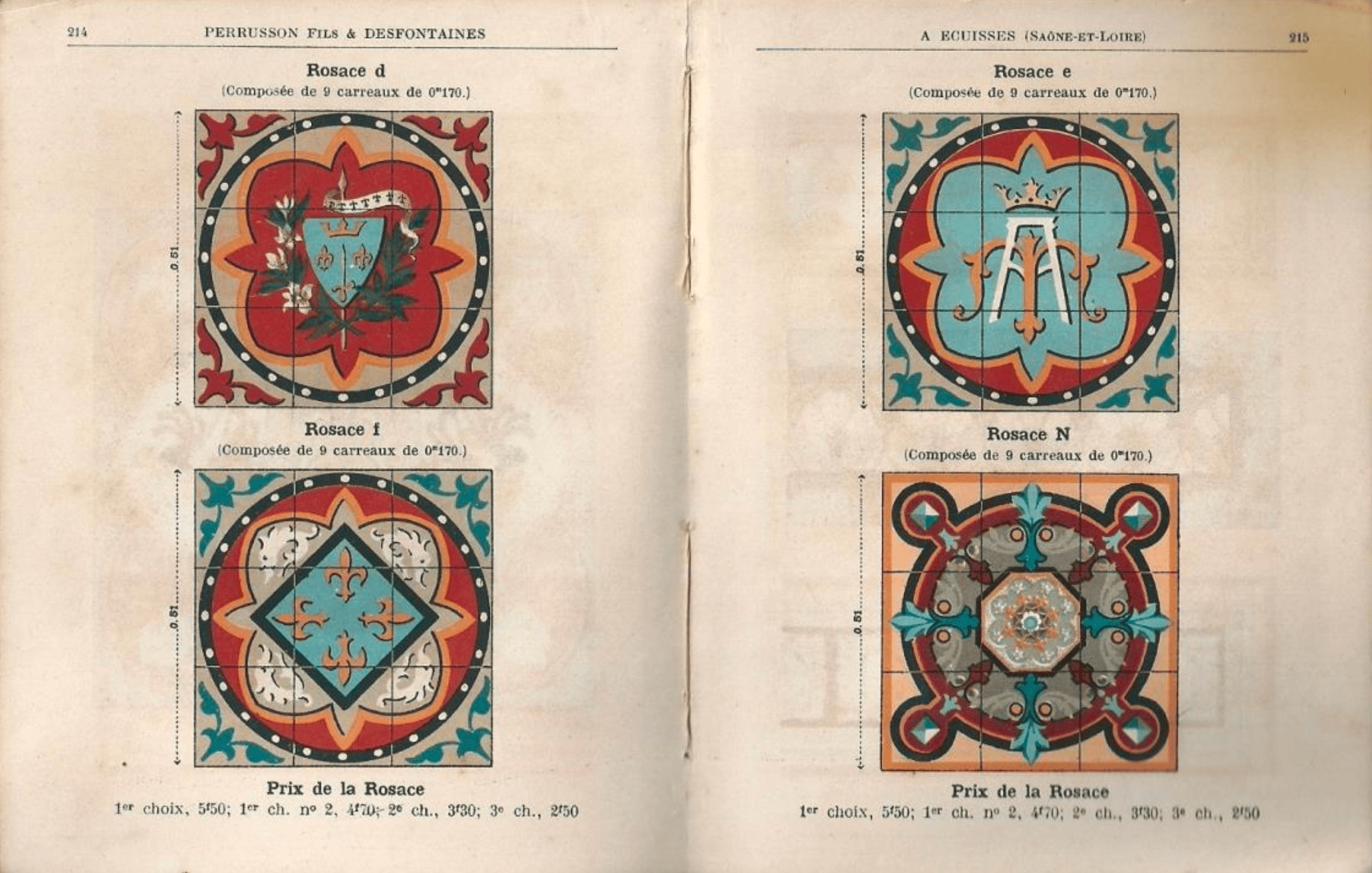
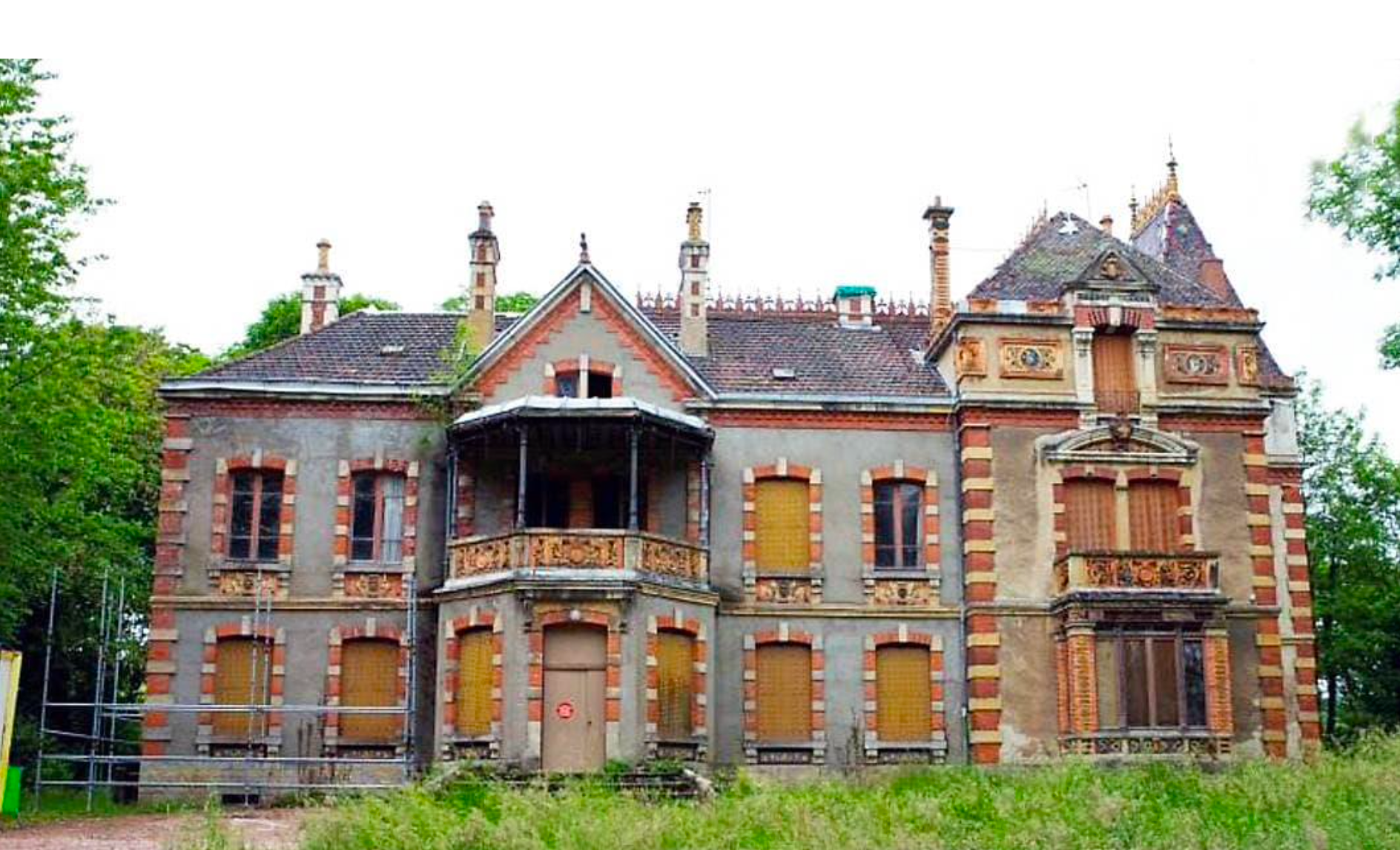
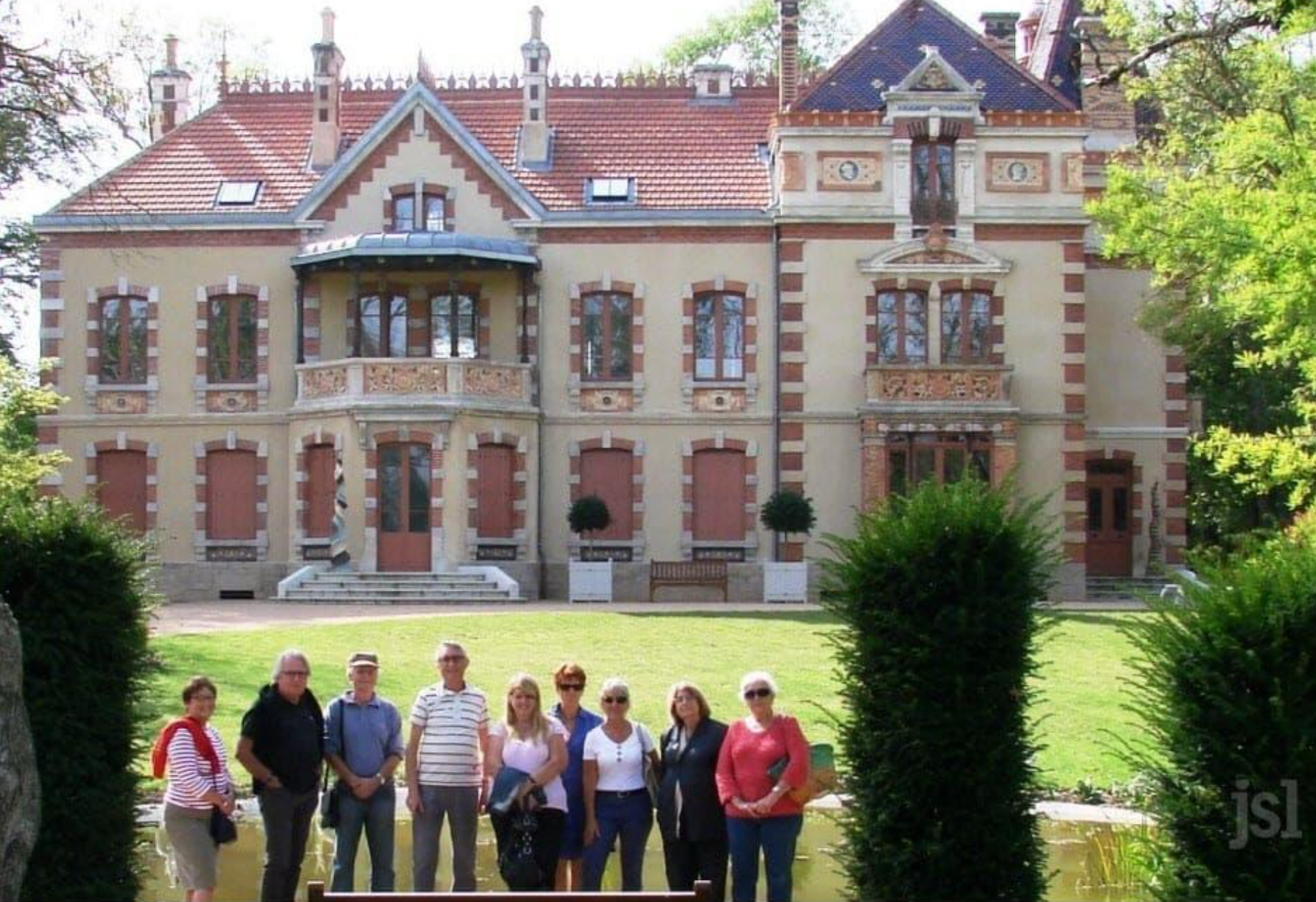
The Perrusson Villa, long derelict, has been fully restored by the French State and is open for tours.
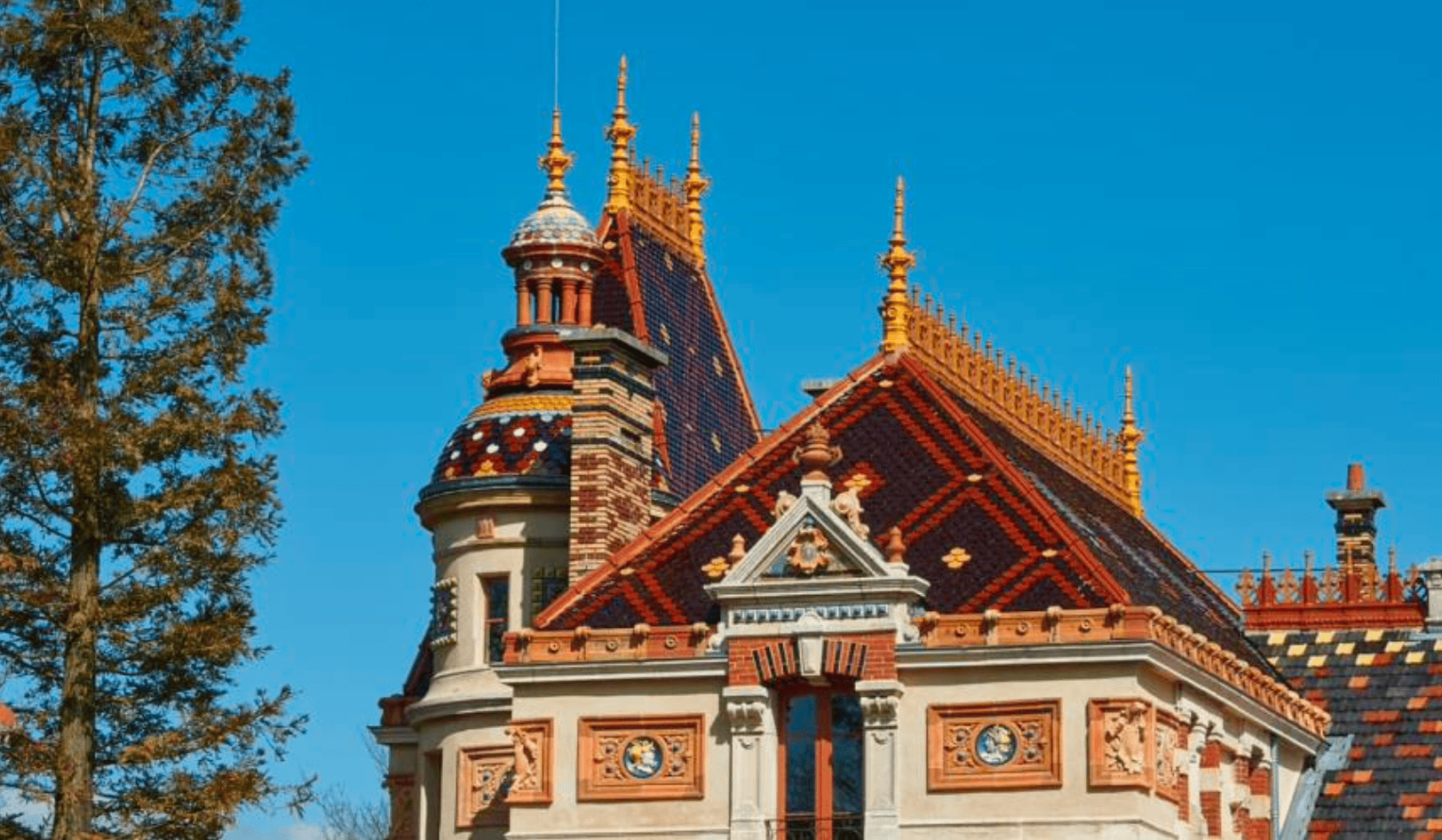
Detail of the Perrusson family home, now a museum
In 1882 the Fabrique de Carrelages Mosaïques en grès cérame vitrifié Leon Vaucamps & Cie was established in Douzies-Maubeuge (Nord). This company came in 1889 under a new direction and changed its name in S.A. Produits Céramiques de Maubeuge. The factory remained active under the name Douzies Carrelage until 1989 and under the name Desvres until 1996.
Also in 1882, the Manufacture de carrelages céramiques de Canteleu-Lille, Léon De Smet & Cie (Nord), was founded. The firm was from December 1907 onwards continued by Jean Van Overstraeten as successor. Shortly after the First World War, this latter firm was grouped with Sand & Cie and Simons & Cie in the Société générale de carrelages et de produits céramiques, with headquarters in Paris, which was itself taken over by Villeroy & Boch in 1955.
Amongst the first manufacturers must also be counted A. Defrance & Cie, later continued as the S.A. de Produits céramiques Pont-Sainte-Maxence (Oise). The Belgian firm of Louis Escoyez & Cie who specialised in stove tiles and pavement quarries also saw a future on the French market and built a branch at Mortagne-du-Nord in 1892.
In 1894, the Manufacture de Carreaux Céramiques de Lomme-lez-Lille, Boucquet & Winckelmans (Nord), was founded, a firm that has remained active in this sector until today.
New tile factories founded after 1900
The Manufacture de carrelages céramiques Octave Colozier in Saint-Just-des-Marais (Oise) belonged shortly before the First World War to the biggest French floor tile producers. Colozier had succeeded his father and grandfather as a brick producer but specialised quickly in the manufacture of ceramic tiles. Around 1904 he set up a design studio under the direction of the talented painter Gabriel Lelièvre. Shortly afterwards the production of dust pressed encaustic tiles was started.
Equally important was the in 1905 established S.A. Compagnie Française Mosaïque Céramique de Maubeuge with a factory at Montplaisir near Maubeuge (Nord). This company merged in 1925 with the Société Française des Céramiques de Landrecies (Nord), founded in 1909. The two factories were taken over by the Groupe Desvres around 1984.
Most of the above mentioned factories also exported a considerable part of their production, not only to neighbouring countries, but also throughout the world, thanks to an extensive network of local agents.
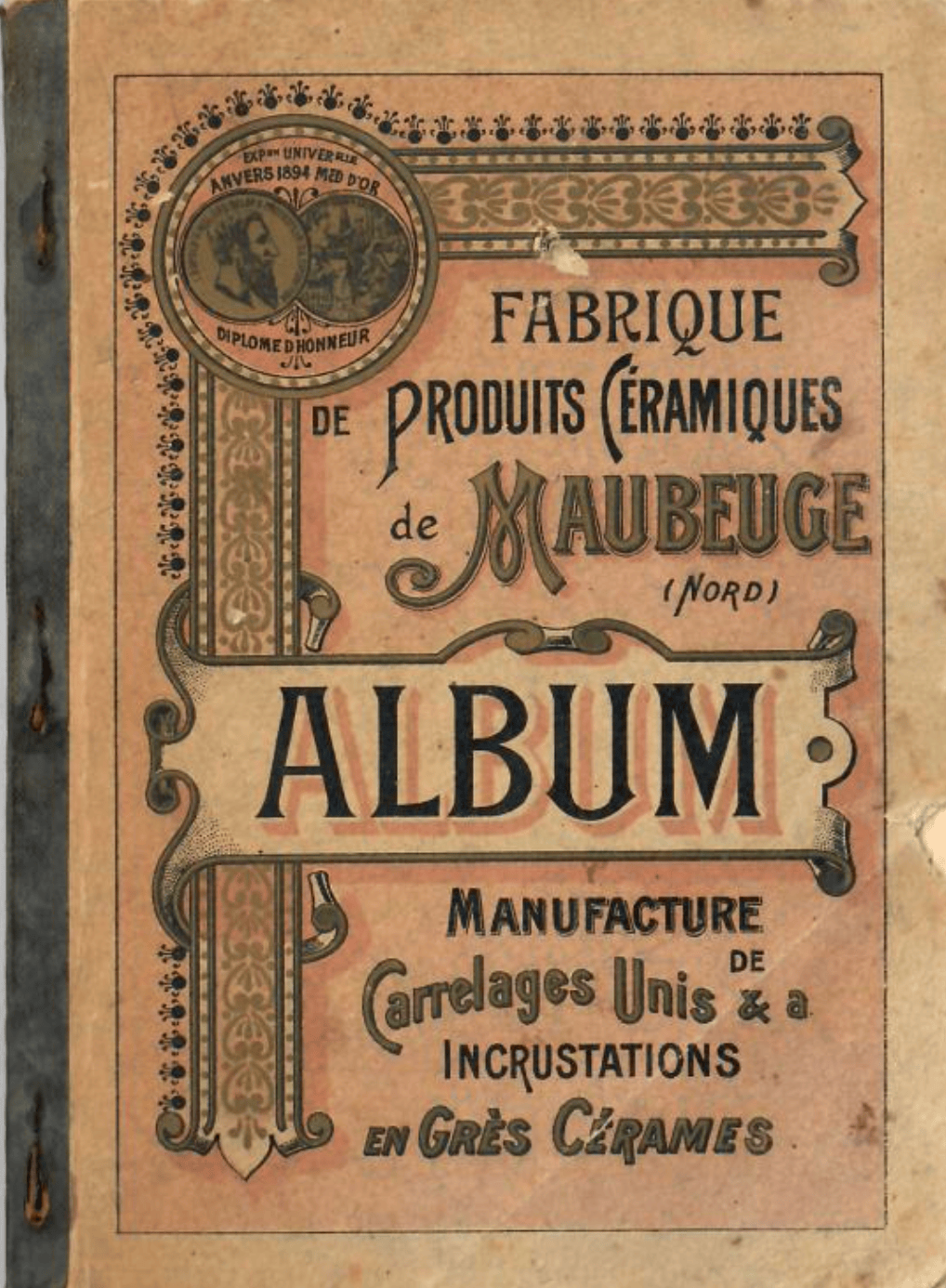
The 1894-1896 catalogue cover
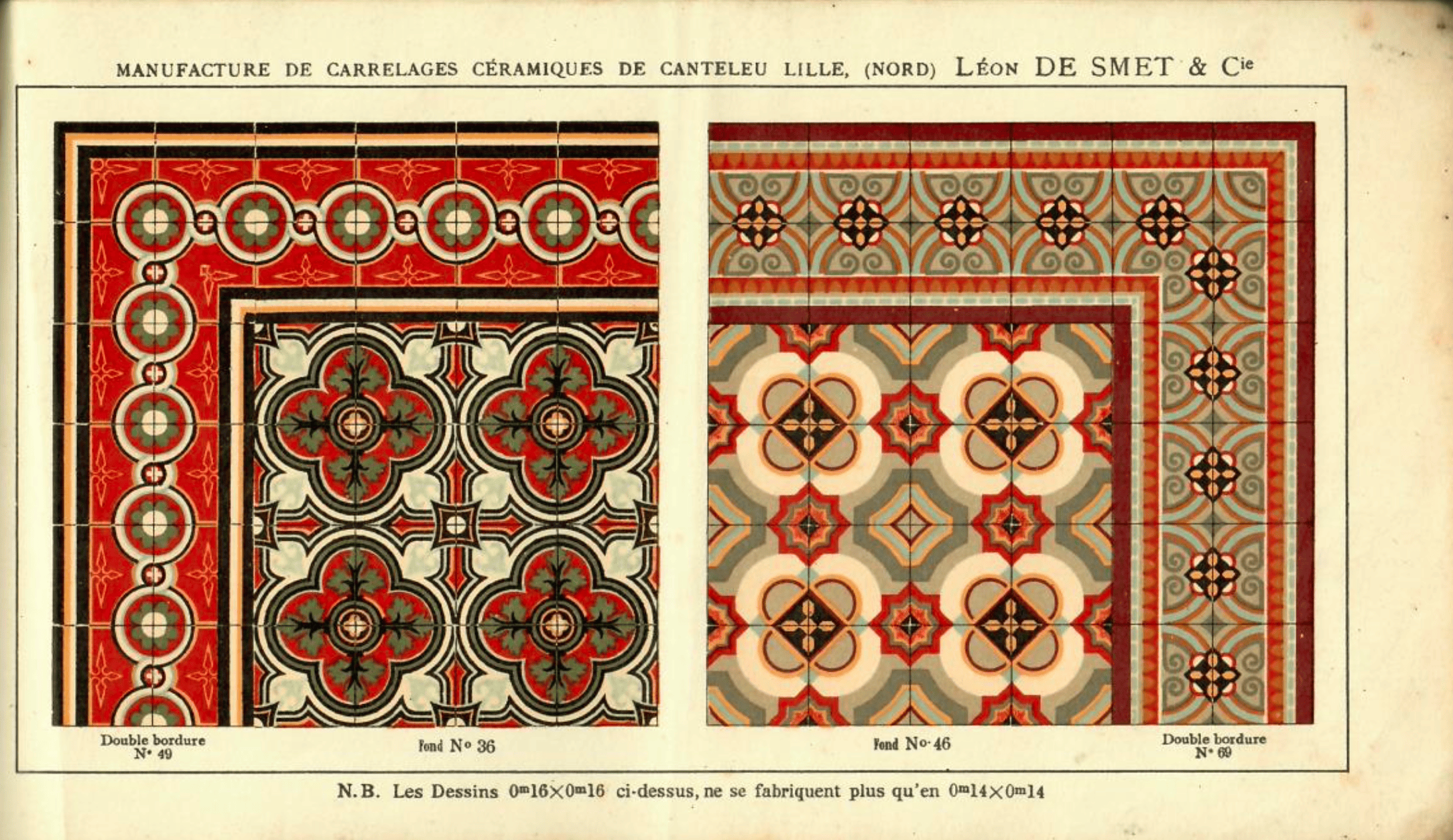
Scan from the period Leon de Smet & Co. catalogue
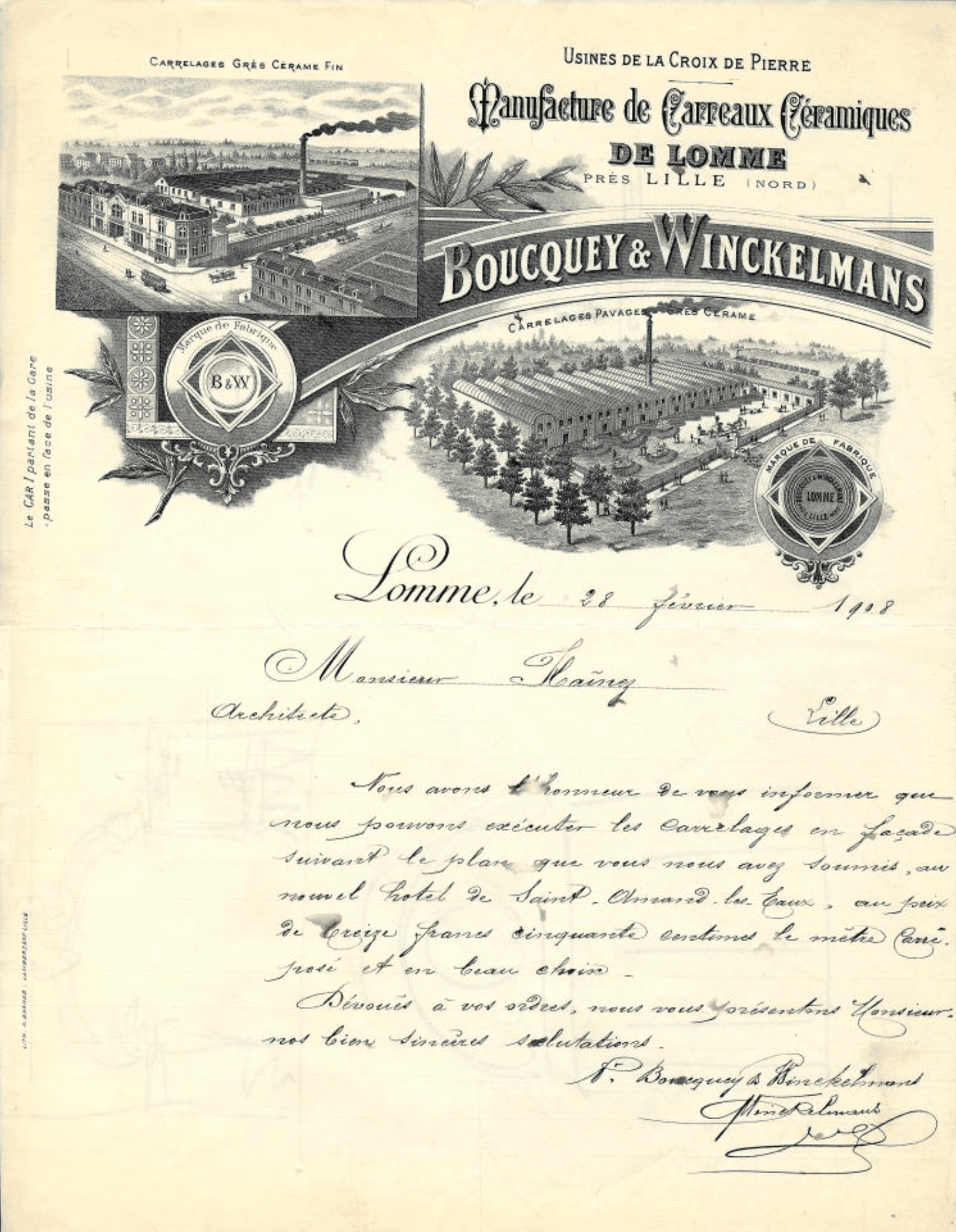
Text & illustrations by Mario Baeck, Doctor in art sciences, Curator of the Gilliot & Roelants Tile Museum in Hemiksem (Belgium)